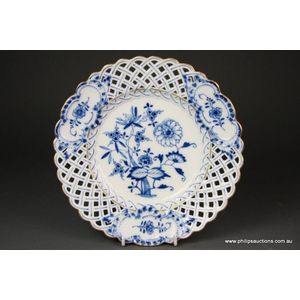Meissen Blue Onion Reticulated Plate with Chinoiserie Design
A Meissen blue and white reticulated plate, circa 1973, in 'Blue onion' pattern, with a chinoiserie design to the centre, the pierced lattice edging interspersed with three shaped and moulded panels also with floral motifs; crossed sword marks underside and impressed numerals 151 and other cipher. Height 3.5 cm. Diameter 23.5 cm
You must be a subscriber, and be logged in to view price and dealer details.
Subscribe Now to view actual auction price for this item
When you subscribe, you have the option of setting the currency in which to display prices to $Au, $US, $NZ or Stg.
This item has been sold, and the description, image and price are for reference purposes only.
- Onion Pattern - The onion pattern is a popular design motif used in the decoration of porcelain, especially in European and Chinese porcelain. It typically consists of a central motif, such as a flower or bird, surrounded by concentric circles of leaves, flowers, and other decorative elements. The onion pattern originated in China during the Ming dynasty (1368-1644) and was later adapted by European porcelain makers in the 18th century, by companies such as Meissen, Royal Copenhagen and Hutschenreuther, and in England by manufacturers such as Royal Wedgwood, Crown Derby and Spode. The name "onion pattern" is thought to have originated from the shape of the central motif, which resembles an onion or a pomegranate. The pattern is often executed in underglaze blue, but it can also be found in other colours such as red, green, and gold.
- Chinoiserie - Furniture and decorative items decorated in imitation of a Western interpretation of the Chinese style. The Chinoiserie style first became popular in the late 17th century, though there were frequent revivals, notably by Chippendale (hence 'Chinese Chippendale') during the Regency period, and the Anglo-Japanese style in the second half of the 19th century.
The ubiquitous 'willow pattern' is the most common 'Chinese' theme used in porcelain, while on furniture the Chinoiserie style usually has black or red painted and lacquered decoration, though the hallmark of the furniture style is the use of fretwork in geometrical patterns, pagodas and other decorative forms.
Japonaiseries, as the name implies, are motifs in imitation of the Japanese taste.
See also "Chinese Chippendale". - Circa - A Latin term meaning 'about', often used in the antique trade to give an approximate date for the piece, usually considered to be five years on either side of the circa year. Thus, circa 1900 means the piece was made about 1900, probably between 1895 and 1905. The expression is sometimes abbreviated to c.1900.
This item has been included into following indexes:
Visually similar items

Quality Meissen onion pattern dish, coloured with lattice work border
Sold by
in
for
You can display prices in $Au, $US, $NZ or Stg.

Antique Delft blue & white plate, approx 27 cm wide
Sold by
in
for
You can display prices in $Au, $US, $NZ or Stg.

First Period Worcester small scallopped edge dish 'Pine Cone' pattern
Sold by
in
for
You can display prices in $Au, $US, $NZ or Stg.

18th century ?Dr Wall? first period Worcester underglazed blue ?Pomegranit? patterned shallow porcelain Bo. 19 cm diameter
Sold by
in
for
You can display prices in $Au, $US, $NZ or Stg.
